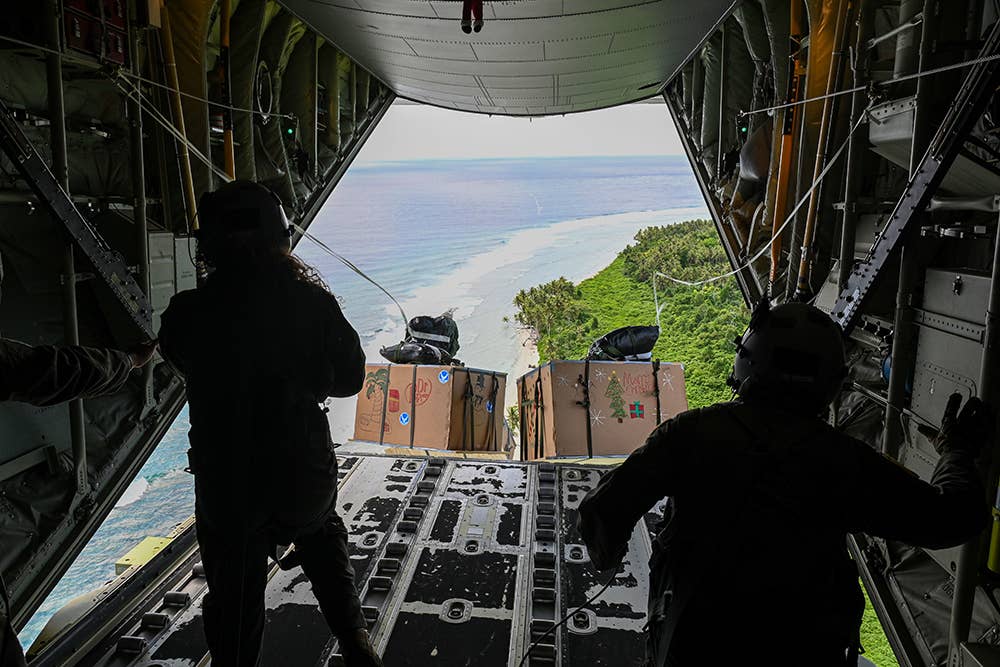
U.S. Air Force Senior Airman Kim Doyle, and U.S. Air Force Airman 1st Class Spencer Kans, loadmasters assigned to the 36th Airlift Squadron, Yokota Air Base, Japan, watch as bundles fly off an aircraft during Operation Christmas Drop at Andersen Air Force Base, Guam, Dec. 10, 2021. U.S. Air Force photo by Senior Airman Aubree Owens
Santa came early this year for dozens of island communities in the South Pacific, powered not by nine reindeer, but instead four Rolls-Royce turboprop power plants, each generating 4,700 horsepower.
Last week, U.S. Air Force crew members concluded an annual weeklong airdrop of food, tools, fishing equipment, and clothing out the back of C-130 Hercules to more than 55 remote islands in the southeastern Pacific. The drop zones, which include the Federated States of Micronesia and the Republic of Palau, stretch across a 1.8 million square nautical mile operating area, according to the service.
“The aerial delivery enables aircrews to develop and maintain combat readiness through aircraft generation and recovery, while delivering donations provided by private donors, charitable organizations and the University of Guam, to over 22,000 residents across the remote islands in the region,” the USAF said.
The Long History of the Christmas Drop
The 70-year-old military tradition is the Department of Defense’s longest-running humanitarian and disaster relief training mission, based out of Andersen Air Force Base, Guam.
USAF has conducted an airdrop of supplies for island communities in the southeastern Pacific every year since 1952—the same year Queen Elizabeth took the throne, the first effective polio vaccine was invented, and “The Adventures of Ozzie and Harriet” debuted on ABC.
The long-held military tradition began when the aircrew of a B-29 Superfortress conducting weather reconnaissance in the area on Christmas Day spotted islanders waving from the island of Kapingamarangi, an atoll in southern Micronesia that today has a population of about 500. The crew dropped some supplies attached to a parachute, launching with the bundle a new annual ritual of giving.
Today, the bundles are filled with donated items, such as canned goods, children’s books, cookware, hygiene products, shoes, toys, towels, and fruit and vegetable seeds, and are dropped off the coast, where they float to the shoreline.
In addition to giving bundles of necessities, the annual event provides an opportunity for aircrews in the region.
During the weeklong mission, Pacific Air Forces airmen from the 36th Wing from Andersen Air Force Base, Guam, 515th Air Mobility Operations Wing from Joint Base Pearl Harbor-Hickam, Hawaii, and the 374th Airlift Wing from Yokota Air Base in Japan partner with airmen from other nations in the region.
“This training mission is not only a tradition, but provides relevant and real training necessary for our Airmen and partner nations in the Indo-Pacific region,” said Gen. Ken Wilsbach, Pacific Air Forces commander. “I want to thank our partner nations, whether they participate in the air drop or serve as an international observer, because together we’re working to strengthen our readiness and resolve for when the next disaster strikes in the region.”
The event is a low-cost way to provide critical training in interoperability and communication when it comes to preparing for potential disaster relief mission coordination, according to service officials.
This year, airmen from the Republic of Korea participated in the preparation of the airdrop for the first time by using the Osan Air Base runway for takeoff and landing, according to USAF.
“It was a valuable joint training event enabling the exchange of tactics, techniques, and procedures improving interoperability between the forces,” said Maj. Joseph Park, 607th Air Support Operations Group air mobility liaison officer, who facilitated the event. “It was a chance to learn from each other with a shared goal of maintaining trust, proficiency and readiness.”

Subscribe to Our Newsletter
Get the latest FLYING stories delivered directly to your inbox






